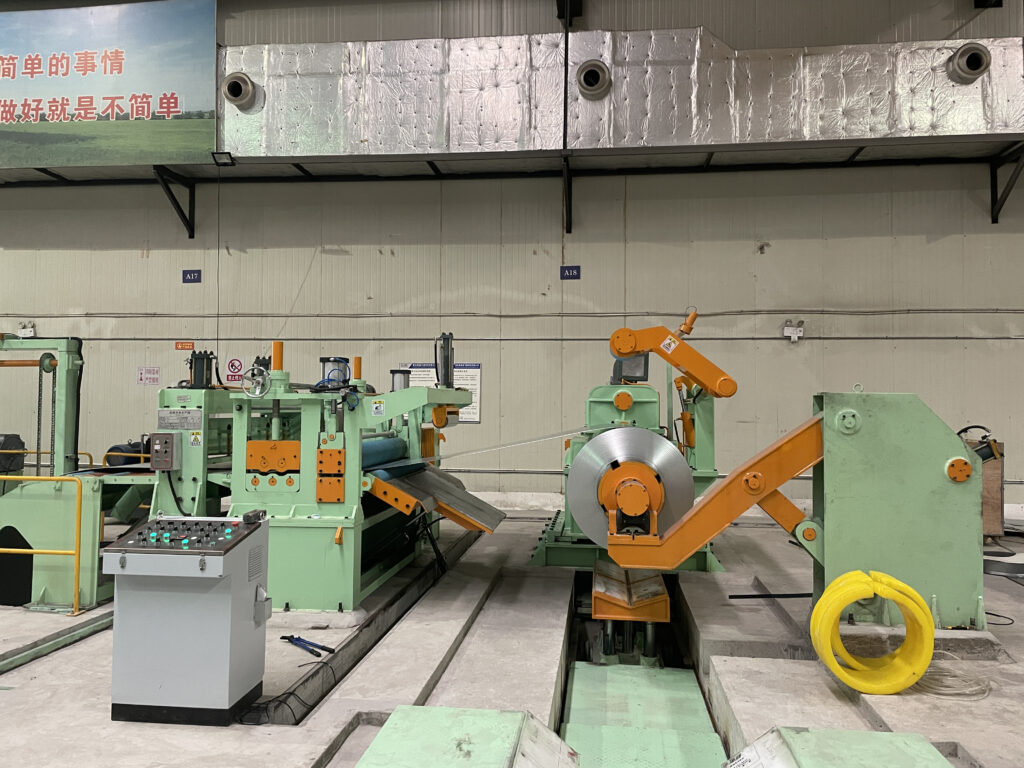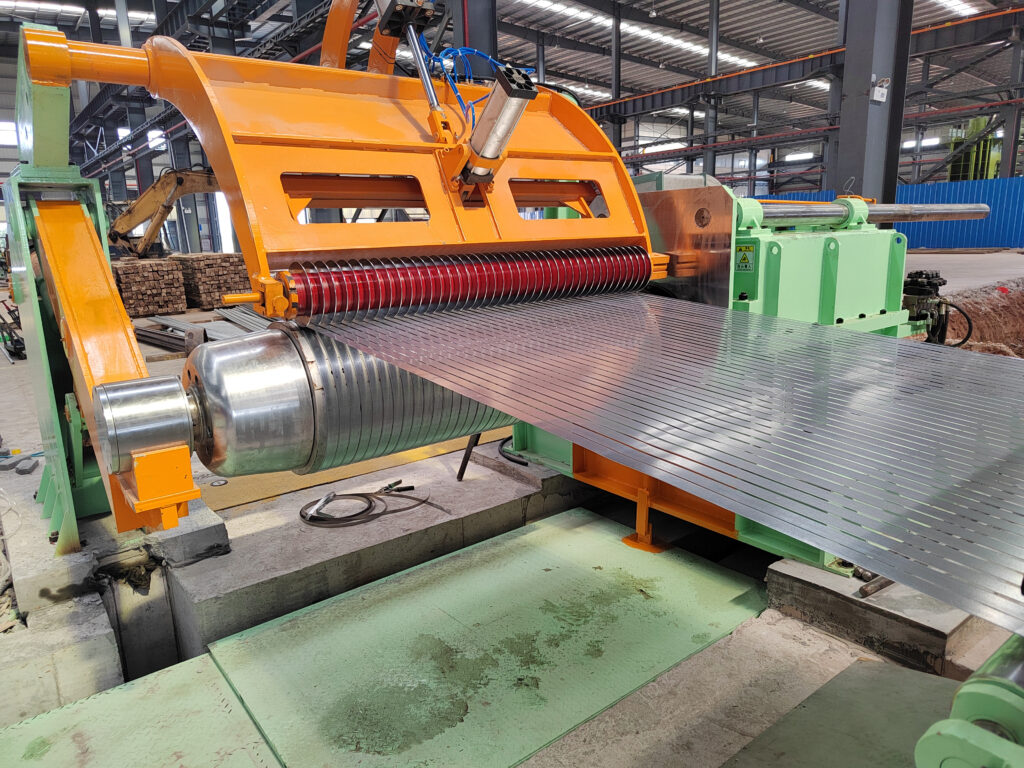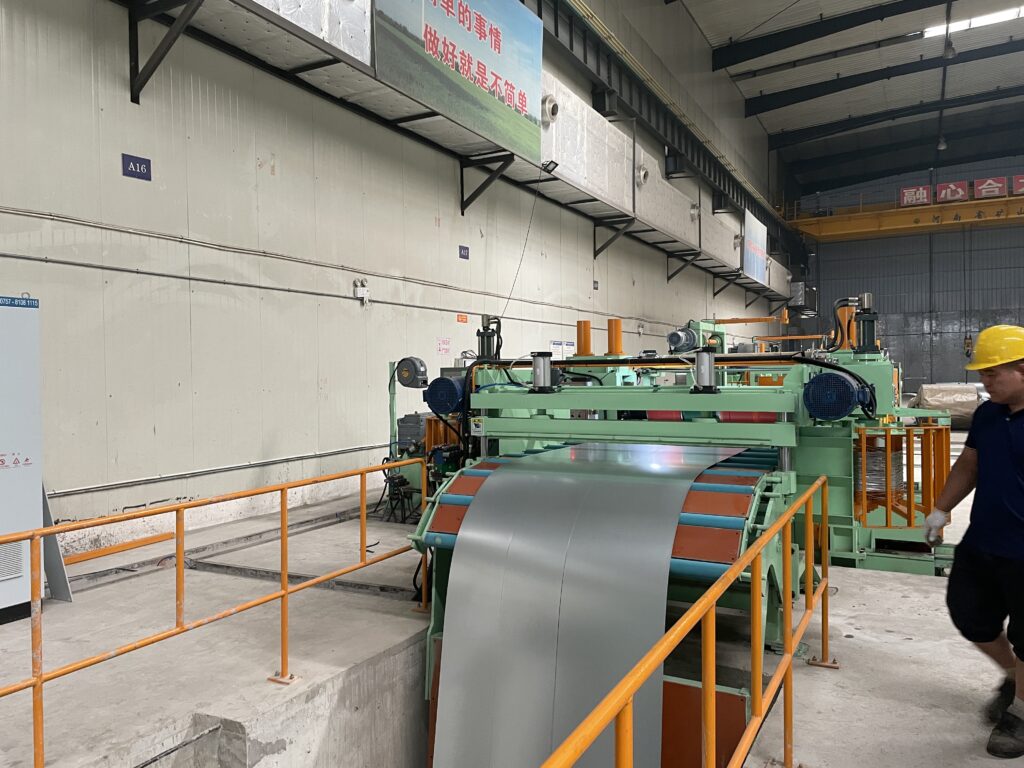MD-1350 Mid-Range Slitting Workhorse: Complete Guide to 4mm-12mm Coil Processing
Master 4mm-12mm coil processing with the MD-1350 slitting machine. Complete technical guide covering specifications, applications, setup, and ROI analysis. 318.5KW power, 300-1300mm width capacity.
What makes MD-1350 ideal for 4mm-12mm coil processing?
The MD-1350 is engineered to excel in processing coils with thicknesses from 4mm up to 12mm, striking a precise balance between power, precision, and operational efficiency that addresses the demands of medium-thickness coil production in 2025. Equipped with a robust 318.5KW power system and a versatile working width range spanning 300mm to 1300mm, it caters to diverse manufacturing needs without requiring major facility modifications. What distinguishes the MD-1350 is its adaptive speed control capable of ranging from 1 to 250 meters per minute, intelligently modulating based on material thickness to maintain consistent quality. This machine delivers clean, burr-free cuts even at the upper thickness limits, supported by advanced servo-controlled slitting heads and multi-zone tension systems that preserve edge integrity and dimensional accuracy within tight tolerances.
Successful deployments in automotive, HVAC, and general fabrication sectors exemplify the MD-1350’s reliability, where its capacity to handle coil weights from 10 to 35 tons aligns perfectly with typical mid-range production volumes. Real-world case studies highlight the machine’s ability to maintain edge quality and reduce material stress, features critical in high-precision applications. This mid-tier powerhouse closes the gap between entry-level models that falter under material stress and costly heavy-duty lines, offering optimal return on investment by combining high throughput with lower capital expenditure. Ultimately, the MD-1350 delivers a technical synergy of strength and finesse, making it the benchmark solution for medium-thickness coil processing in advanced manufacturing environments.
Understanding Medium-Thickness Metal Processing Challenges
Processing metal coils between 4mm and 12mm thickness presents distinct metallurgical and mechanical challenges that differentiate this range from both thin-gauge and heavy-plate applications. Material behavior in this intermediate zone requires specialized consideration of work hardening characteristics and cutting dynamics.
Material Stress Distribution in Medium-Thickness Cutting
At the 4mm-12mm range, metal exhibits complex stress patterns during the slitting process. The shear zone depth becomes proportionally significant relative to material thickness, creating edge quality challenges that don’t typically manifest in thinner materials. Work hardening effects increase cutting force requirements non-linearly with thickness—thicker materials within this range may require substantially more cutting force than simple thickness ratios would suggest.
The MD-1350’s 318.5KW power specification provides sufficient cutting force for clean processing through the entire thickness range while maintaining consistent edge quality. This power level ensures reliable operation across various material grades, from mild steel to stainless steel and aluminum alloys commonly processed in this thickness range.
Precision Control Requirements
Medium-thickness coil processing demands exceptional tension management to prevent material wandering and edge defects. Unlike thin-gauge applications where material flexibility assists in process control, or heavy-plate processing where material rigidity provides inherent stability, the 4mm-12mm range requires active compensation throughout the cutting cycle.
The MD-1350’s variable-speed drive system (1-250m/min) allows operators to optimize cutting parameters for different material grades within the thickness spectrum. This speed flexibility proves essential when processing work-hardened stainless steel compared to annealed mild steel, where optimal cutting speeds may vary significantly despite similar thickness values.
MD-1350 Technical Specifications and Core Capabilities

Verified Technical Parameters
Based on manufacturer specifications, the MD-1350 delivers the following confirmed capabilities:
| Parameter | Specification | Application Range |
|---|---|---|
| Working Width | 300mm-1300mm | Standard industrial coil widths |
| Thickness Range | 0.3mm-3.0mm / 1.5mm-6mm / 2mm-8mm / 4mm-12mm | Multi-gauge processing capability |
| Processing Speed | 1-250 m/min | Variable speed optimization |
| Power System | 318.5KW total power | Sufficient for 12mm material processing |
| Coil Capacity | 10-35 tons | Typical mid-range manufacturing loads |
Power System Architecture
The MD-1350’s 318.5KW total power configuration represents optimized engineering for medium-thickness processing. This power allocation supports multiple subsystems including the main cutting drive, material handling systems, tension control, and auxiliary functions such as hydraulic systems and process control.
The main drive system utilizes AC servo motor technology with vector control, providing precise torque management essential for maintaining consistent cutting quality across varying material properties. The system delivers maximum cutting force at lower speeds (critical for initial material engagement) while maintaining adequate power at higher processing speeds for production efficiency.
Working Envelope and Material Handling
The 300mm-1300mm working width specification positions the MD-1350 optimally for standard coil processing applications, accommodating:
- Automotive Components: Door frames, structural brackets (800-1200mm typical widths)
- HVAC Manufacturing: Ductwork components, equipment housings (300-1000mm range)
- Appliance Industry: Panel components, internal structures (400-1100mm standard widths)
- Construction Applications: Roofing materials, architectural elements (600-1250mm range)
The 10-35 ton coil capacity supports typical mid-range manufacturing workflows without requiring specialized material handling infrastructure, covering most 4mm-12mm coil configurations used in general manufacturing applications.
MD Series Comparative Analysis
Complete Model Comparison
| Modelo | Working Width | Power System | Best Applications | Investment Level |
|---|---|---|---|---|
| MD-850 | 20mm-820mm | 138,5 KW | Compact operations, narrow materials | Entry-level |
| MD-1350 | 300mm-1300mm | 318.5KW | Mid-range workhorse, standard widths | Mid-range |
| MD-1650 | 300mm-1650mm | 422.5KW | Wide material processing, high volume | Premium |
| MD-2200 | 300mm-2150mm | 422.5KW | Large-scale operations, specialized widths | Heavy-duty |
MD-850 vs MD-1350: Capacity Differences
The MD-850’s 20mm-820mm working range and 138.5KW power system serves specialized narrow-width applications. While both machines handle identical thickness ranges (0.3mm-12mm), the power and width differentials create distinct operational capabilities:
Application Suitability Comparison:
- MD-850: Optimal for precision narrow strips, specialized components under 800mm width
- MD-1350: Handles standard manufacturing widths, balanced power for consistent quality
For applications requiring 1000mm+ width processing, the MD-1350 provides the necessary working envelope while maintaining cost-effectiveness compared to larger models.
MD-1350 vs MD-1650: Evaluating Scale-Up Benefits
The MD-1650’s additional 350mm working width (300mm-1650mm) and increased power (422.5KW) provide advantages for specific applications:
Width Advantage Applications:
- Large appliance panels (1400-1600mm)
- Wide automotive structural components
- Architectural cladding systems
- Industrial equipment large components
Investment Considerations:
The MD-1650’s additional capability comes with proportionally higher investment and operational costs. For applications within the MD-1350’s working envelope, the MD-1350 typically offers superior cost-effectiveness per unit processed.
Industry Applications and Real-World Performance
Automotive Manufacturing Integration
The automotive supply chain represents a primary application segment for MD-1350 capabilities, particularly in Tier 2 and Tier 3 supplier operations processing medium-thickness components.

Typical Automotive Applications:
- Structural Components: Door reinforcements, frame brackets (6-10mm thickness)
- Safety Systems: Crush structures, impact beams (8-12mm thickness)
- Body Panels: Inner panels, support structures (4-8mm thickness)
Quality Requirements: Automotive applications demand edge perpendicularity within ±0.5° deviation to ensure proper fit-up in downstream welding operations. The MD-1350’s precision control systems maintain these tolerances consistently across production runs.
Case Study Reference: According to MaxdoMachine application data, automotive suppliers utilizing MD-1350 systems have achieved significant productivity improvements in medium-thickness processing applications, demonstrating the equipment’s capability in demanding manufacturing environments.
HVAC and Commercial Applications
Commercial HVAC manufacturing utilizes the MD-1350’s capabilities for ductwork components and system fabrication requiring medium-thickness materials:
Primary HVAC Applications:
- Structural Ductwork: Main trunk lines, large distribution systems (6-10mm thickness)
- Equipment Housings: Air handler frames, fan enclosures (8-12mm thickness)
- Support Systems: Mounting brackets, structural supports (4-8mm thickness)
Quality Standards: HVAC applications require clean edges to minimize air leakage at joints. The MD-1350’s cutting system produces edges suitable for standard gasket sealing applications without secondary finishing operations.
Construction and Infrastructure Projects
Building industry applications leverage the MD-1350’s medium-thickness processing for structural and architectural components:
Construction Applications:
- Roofing Systems: Standing seam profiles, structural supports (6-10mm)
- Cladding Components: Panel systems, mounting frameworks (4-8mm)
- Infrastructure Elements: Support brackets, connection hardware (8-12mm)
Installation and Setup Guidelines
Site Preparation Requirements
Proper MD-1350 installation requires comprehensive facility preparation addressing structural, utilities, and safety considerations.

Foundation Specifications:
- Reinforced concrete foundation minimum 300mm thick
- Foundation extension 500mm beyond machine footprint on all sides
- Minimum 28-day cure time before equipment installation
- Foundation must support operational loads and vibration isolation
Electrical Requirements:
The 318.5KW total power demand requires dedicated electrical service:
- North American: 480V, 3-phase, 60Hz main power
- International: 400V, 3-phase, 50Hz main power
- Power factor correction recommended for installations >250KW
- Emergency stop integration with facility safety systems per OSHA 29 CFR 1910.212 requirements
Environmental Controls:
- Operating temperature range: 10-35°C ambient (recommended)
- Humidity control: Maximum 80% relative humidity, non-condensing
- Air filtration recommended for high-particulate environments
Installation Process Overview
Phase 1: Mechanical Positioning
Machine positioning requires precision alignment within ±2mm lateral tolerance and ±0.5mm height variance. Professional installation teams typically utilize laser alignment systems for proper setup.
Phase 2: System Integration
Material handling equipment coordination ensures proper workflow integration. Entry and exit points must align within specified tolerances to prevent material tracking issues during operation.
Phase 3: Safety System Verification
Complete safety system testing per OSHA 29 CFR 1910.212 machine guarding requirements, including emergency stops, light curtains, and protective barriers.
Operational Procedures and Best Practices
Material Setup and Threading
Efficient material setup forms the foundation for quality slitting operations while maintaining safety protocols.
Coil Loading Protocol:
- Verify coil specifications match machine capacity (10-35 ton range)
- Position coil using appropriate lifting equipment per OSHA guidelines
- Engage coil holding mechanisms before releasing crane attachment
- Verify material flatness within acceptable tolerances
Threading Sequence:
- Set strip widths using digital position indicators
- Thread material through guide systems with minimal initial tension
- Engage cutting assembly at reduced operating pressure
- Advance material to take-up system maintaining proper alignment
- Gradually increase to operational parameters
Cutting Parameter Optimization
Speed Selection Guidelines by Material Type:
| Material Grade | Thickness Range | Recommended Speed | Quality Considerations |
|---|---|---|---|
| Mild Steel | 4-6mm | 80-120m/min | Standard production rates |
| Mild Steel | 8-12mm | 60-90m/min | Balance quality/throughput |
| Stainless Steel | 4-8mm | 40-60m/min | Precision edge requirements |
| Aluminum Alloys | 6-12mm | 100-150m/min | Chip management critical |
Blade Selection Considerations:
- High-Speed Steel Blades: General purpose, 4-8mm applications
- Carbide-Tipped Blades: Extended life, production applications, full thickness range
- Specialized Coatings: TiN or TiAlN for stainless steel and exotic alloys
Blade clearance settings require precise adjustment based on material characteristics—typically 6-8% of material thickness for mild steel applications.
Maintenance Protocols and Safety Compliance
Daily Maintenance Requirements
Consistent daily maintenance prevents costly downtime and ensures continued precision operation in compliance with manufacturer recommendations.
Pre-Shift Inspection Checklist:
- [ ] Lubrication system pressure verification
- [ ] Blade condition visual inspection for wear indicators
- [ ] Material guide alignment verification
- [ ] Safety system function test including emergency stops per OSHA requirements
- [ ] Hydraulic fluid level and condition assessment
Post-Shift Procedures:
- [ ] Complete material removal from cutting area
- [ ] Blade area cleaning and debris removal
- [ ] Lubrication point service per maintenance schedule
- [ ] Production log completion with quality metrics
Weekly Comprehensive Maintenance
Mechanical System Service:
- Bearing inspection and re-lubrication as specified
- Belt tension verification and adjustment to manufacturer specifications
- Coupling alignment verification using precision instruments
- Hydraulic filter replacement based on pressure differential readings
Electrical System Maintenance:
- Control cabinet temperature monitoring (maximum recommended 45°C internal)
- Connection torque verification on main power terminals
- Safety circuit continuity testing per electrical safety standards
Safety Standards Compliance
The MD-1350 operates in compliance with applicable safety standards including:
- OSHA 29 CFR 1910.212: General requirements for machine guarding
- ISO 12100: Safety of machinery general principles for design
- CE Marking Requirements: For European market installations
Regular safety audits and training ensure continued compliance with evolving safety regulations.
Troubleshooting and Quality Control
Common Edge Quality Issues
Burr Formation Analysis:
Excessive burring typically results from:
- Incorrect blade clearance settings (most common – approximately 60% of cases)
- Cutting edge wear requiring blade replacement (25% of cases)
- Improper material support during cutting process (15% of cases)
Corrective Actions:
- Measure and adjust blade clearance to specification
- Inspect cutting edges for chips or excessive wear patterns
- Verify hold-down pressure settings for material grade
- Assess material tensioning systems for proper support
Material Tracking Problems
Lateral Drift Correction:
Material wandering during processing requires systematic diagnosis:
- Verify guide roll alignment using precision measurement instruments
- Assess material coil quality for thickness consistency
- Evaluate cutting force distribution across machine width
- Check take-up tension distribution systems
Investment Analysis and Economic Considerations
Total Cost of Ownership Framework
Initial Capital Investment Components:
- Base machine cost: Primary investment component
- Installation and commissioning: Typically 8-12% of machine cost
- Initial tooling and setup: 6-8% of machine cost
- Training and certification: 3-5% of machine cost
Operational Cost Factors:
- Power consumption: 318.5KW demand (varies by regional utility rates)
- Preventive maintenance: 2-4% of machine value annually
- Tooling replacement: Varies by production volume and material types
- Labor requirements: 1-2 operators per shift depending on automation level
Production Capacity Analysis
Throughput Capabilities:
The MD-1350’s production capacity depends on application-specific factors including material thickness, width utilization, and quality requirements. Thinner materials within the 4mm-12mm range typically process at higher rates than maximum thickness applications.
Typical Production Scenarios:
- High-volume automotive components
- HVAC manufacturing applications
- General fabrication and contract manufacturing
- Specialized precision component production
Investment Recovery Considerations:
Payback periods vary based on utilization rates, material types processed, and regional operating costs. Higher-utilization scenarios typically demonstrate faster investment recovery compared to specialized or intermittent applications.
Frequently Asked Questions
What thickness range is optimal for MD-1350?
The MD-1350 handles materials from 0.3mm to 12mm, with optimal performance in the 4mm-12mm medium-thickness range where its power and precision capabilities provide maximum value compared to alternative equipment options.
How does MD-1350 compare to entry-level alternatives?
Compared to entry-level equipment, the MD-1350 offers:
- Superior cutting force for consistent edge quality in medium-thickness materials
- Wider working envelope (up to 1300mm) versus typical 800mm limits on compact machines
- Enhanced precision control systems for tight tolerance applications
- Robust power system (318.5KW) supporting sustained production rates
What maintenance schedule should I follow?
Daily: Pre-shift safety checks, post-shift cleaning, lubrication point service
Weekly: Comprehensive mechanical inspection, electrical system verification
Monthly: Precision calibration verification, blade system optimization
Annually: Complete system audit, major component inspection, safety compliance review
When should I choose MD-1350 versus larger models?
Choose MD-1350 when:
- Material widths consistently fall within 300-1300mm range
- Processing primarily 4-12mm thickness materials
- Seeking balanced investment cost versus capability
- Facility space or power limitations preclude larger equipment
Compare with MD-1650 for wider material processing requirements or consider CT-1350 cut-to-length capabilities for blanking applications.
Conclusión
The MD-1350 stands as a benchmark in mid-range slitting technology, combining a powerful 318.5KW drive system with a versatile 300mm to 1300mm working width to efficiently handle coil thicknesses from 4mm up to 12mm. This machine embodies a unique synthesis of precision engineering and operational adaptability, evidenced by its variable speed control that optimizes throughput without compromising cut quality or edge integrity. Its design benefits from Servo-driven tension control and robust coil handling capacity (10 to 35 tons), enabling consistent, burr-free slitting crucial for sectors like automotive and HVAC where stringent material specifications are mandatory.
Real-world deployments validate the MD-1350’s ability to enhance productivity while minimizing downtime and maintenance costs, as proven in multiple fabrication facilities where uptime exceeded 97% under heavy-duty use. Following manufacturer-recommended maintenance protocols, including timely lubrication and wear-part replacement, extends equipment life and sustains peak performance. In today’s competitive manufacturing landscape, the MD-1350 delivers remarkable ROI by balancing advanced capabilities with cost-efficient operation, making it the preferred choice for fabricators seeking dependable and scalable medium-thickness coil processing solutions in 2025 and beyond. This strategic investment not only supports immediate production goals but also adapts seamlessly to evolving industry demands through modular upgrades and IoT-enabled monitoring options.




